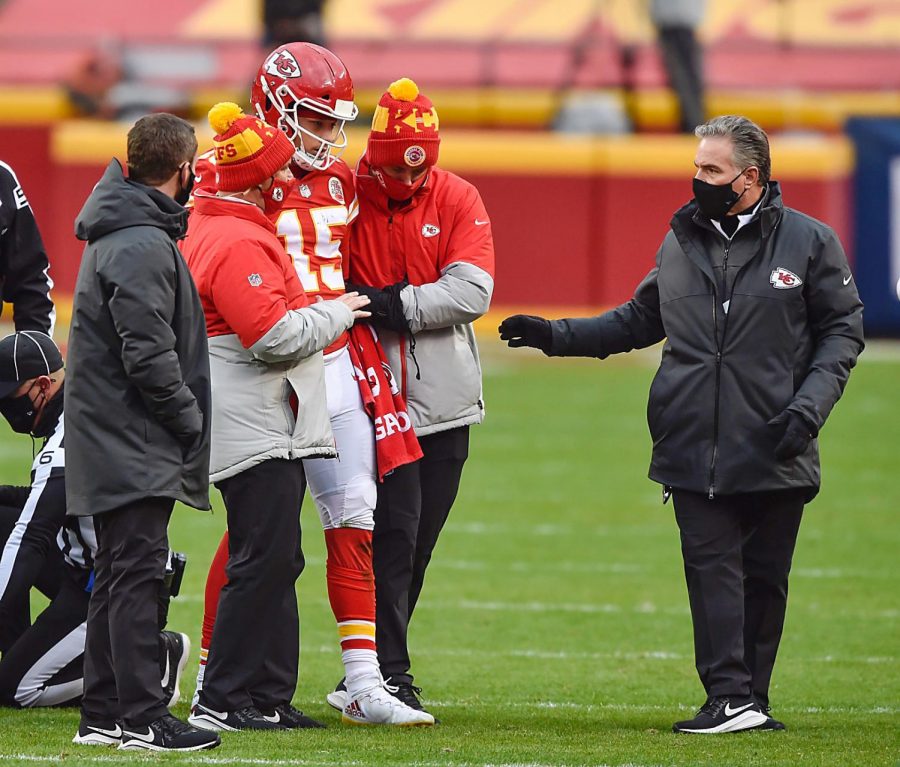The (Next) Most Dangerous Game
PHOTO | TNS
Kansas City Chiefs quarterback Patrick Mahomes is escorted off the field following a concussion-causing hit during his game against the Cleveland Browns on Sun., Jan. 17.
The NFL is notorious for racking up concussions each season. In 2019 alone, 224 concussions were diagnosed and recorded, according to the NFL. There is nearly one concussion for each of the 256 games played. This number, although large, is thought to be an underestimate, as “23 of 44 NFL players — slightly more than half — said they would try to conceal a possible concussion rather than pull themselves out of a game,” according to ESPN and the Associated Press. The NFL is turning a blind eye to their faulty concussion protocol for the sake of gameplay and profit, and it comes with a cost.
When widely beloved Chiefs quarterback Patrick Mahomes hit the ground Sunday, Kansas City felt the blow. Mahomes became a sort of idol, the untouchable, invincible king in the Chiefs’ Kingdom. So, when he was suddenly down for the count, unable to continue playing, uncertainty took his place on the field. Mahomes passed the concussion test, though, and is said to have a “tweaked nerve,” according to CBS Sports Radio.
Seattle Seahawks quarterback Russel Wilson was not as lucky, though; on Nov. 9, 2017, he found himself enveloped in the walls of the infamous blue tent after Referee Walt Anderson spotted his fall, a demonstration of the “see-something-say-something” initiative. He never underwent a concussion test, though, and he exited the tent almost seconds after he was ushered in. He finished the game, and continued practicing in preparation for the Super Bowl. The Seahawks were later sued for $100,000 for neglecting protocol, according to the NFL Players association.
/cdn.vox-cdn.com/uploads/chorus_asset/file/9648117/yourok.0.gif)
Houston Texans quarterback Tom Savage was not so lucky. After his head slammed into the endzone, Savage remained on his back, twitching, arms folded and hands trembling. He was very obviously injured, so fans were shocked to see him re-enter the field just moments after being escorted off. Although he had clear and recognizable signs of a concussion, Savage was cleared to finish out the game, according to ESPN.
These two examples are few of many. The NFL has a duty to protect its players, regardless of profits. Contact sports, such as football, have immense risks and the NFL’s neglect of their responsibility has only increased them. After a potential concussion is spotted, officials are to confiscate said player’s helmet and administer basic concussion testing: an eye movement test and a series of “Maddocks Questions”, such as “At what venue are we today? Which half is it now?Who scored last in this match? What did you play last week?”, according to the NFL’s official “player care” webpage. That’s it.
If the NFL played by the rules of the Missouri State High School Activities Association, “clearance may not be on the same date on which the athlete was removed from play.” Perhaps the difference is pay; high school students pay to play, the league can survive when star players are injured. Teams like the Seahawks, the Texans and the Chiefs act as if monetary intake is more important than sustaining their player’s health. It is crucial that the NFL betters their protocol, and highlights the clear benefits of following it. Former running back Maurice Jones-Drew, one of the 23 of 44 NFL players mentioned earlier, stated that the goal is not to avoid future neurological damage, but to “put food on the table”. His advice: “hide it.” It’s part of the game.



